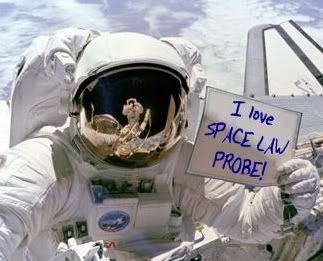9.30.2005
E=mc2
Is Space Pork?

Unless you've been distracted watching Magnificent Desolation and reading only Serenity reviews, you know the blogosphere's PorkBusters campaign to challenge federal lawmakers to cut pork-barrel projects and redirect funds to hurricane relief continues.
Some pork is obvious: Bridges to nowhere or nowhere people really go; a road for Wal-Mart; endless local bike lanes, footpaths and multi-use trails; a graffiti elimination program; a film festival; local park and museum enhancements; a $3 million gym for the House of Representatives; research and marketing grants for local winemakers. You can smell the sizzling pancetta.
But other federal expenditures, while not necessarily meeting the criteria for pork set forth by Citizens Against Government Waste, nonetheless remain extremely objectionable to some taxpayers.
What makes spending wasteful? We all know it when we see it. But we don't all see it the same.
So Space Law Probe is as good a blog as any on which to ponder: Is space pork? Is NASA's newly announced $100 billion-plus moon initiative a "bridge to nowhere"? Fiscally speaking, is the moon made of cheese, or ham?
Even during the Cold War when NASA's mission was clearer, the question of space pork was there. When Hurricane Rita targeted Texas prompting some to question again the wisdom of Mission Control's location, as one blogger opined, "the only reason it was in Texas in the first place was because LBJ was a Texan & wanted the pork to go to his home state."
Some taxpayers are gung ho about the idea of rocketships and space travel, no matter the cost. Others are more likely to favor space spending if their state or congressional district benefits from space appropriations.
Keyword searches in the 2005 Pig Book for "NASA" or "space" turn up lists of space pork. And they're long. So clearly CAGW has a beef, so to speak, with NASA.
And last week, in response to Katrina relief spending, a caucus of conservative House Republicans proposed Operation Offset, a package of cuts which included cancellation of NASA's moon/Mars initiative. However, so far, the plan taken as a whole has not gained wide support.
So where does this leave us? Luckily, helping to spearhead the blogosphere's pork chopping effort, of course, is Professor Reynolds, who loves space and knows it well. If you ask the Professor if space is pork (and I did), he will quickly respond (in inimitable lawyerly fashion), "sometimes," and then refer you to his writings about "moneysaving and capability-improving" ideas for NASA. And he has written much about this.
First, the professor is all for sending humans to the moon and Mars and has written in support of space settlements, for example, here, here, here, here and elsewhere.
And in response to NASA's moon plan, asking and answering the question, Is This the Right Way to Return to the Moon?, Professor Reynolds calls for the development of drastically reduced costs to orbit capabilities such as space elevators, for which the technology is rapidly progressing. (Don't get him started on carbon nanotubes.)
He strongly supports private space ventures and calls for a leaner and meaner space agency in which Mike Griffin does "some serious restructuring and refocusing..." The professor emphasizes, "I think the focus on exploration, as opposed to pure science (or pork) is vital to humanity. As I've written before, the long-term (and even not-so-long-term) prospects for humanity look poor if we don't expand beyond the Earth..."
Favoring productivity-enhancing and cost-saving technologies such as space elevators and other innovations, Professor Reynolds writes, "It's the free market that lowers costs, and empowering such competition will do more to promote American supremacy in space than any single R&D program. And he says, "the real key to successful space settlement over the long term is to take the work away from governments and turn it over to profit-making businesses."
(And importantly, the professor thinks there's nothing wrong with competing with China in space, either.)
The space spending issue can cut across party lines in unexpected ways. There are blue state Democrats who want NASA cut and only private capital, never tax dollars, to fund space ventures. And there are red state Republicans who support a big, strong, federally funded space agency.
In his blog, Jon Goff wrote, "I just think that involuntarily taking billions from the nation to feed the dreams of a few is morally repugnant. That said, I also realize that I'm in the minority on this, and that NASA isn't going away anytime soon. Since NASA isn't going away, I'd at least like to see it try and operate in the least damaging way possible."
Of course the debate about NASA's role with respect to the entrepreneurial space sector looms large, as illustrated for example, by Jeff Foust's thread on NASA's commercial commitment, this post from Clark Lindsay, and this discussion prompted by Rand Simberg (who has said: "The federal establishment has apparently simply given up on the notion of making space affordable. Thus, NASA will make itself increasingly irrelevant as the years go on.") Of course, some space enthusiasts simply don't talk about NASA at all.
Meanwhile, in an endorsement of President Bush's space policy, yesterday the Senate unanimously approved a NASA authorization bill (S.1218). The measure now must be reconciled with a version passed by the House in July (H.R. 3070).
And as the new age of commercial space, personal spaceflight and space tourism takes shape, space will be a mixed bag of federally and commercially funded missions and projects. In America, where everything is still possible, we can have our space and cut the ham too. So for now, if you think we are shooting into space too many or too few of your hard-earned tax dollars, don't just blog about it -- e-mail or call your reps in Congress. But whatever you do, don't offer to take them to lunch.
-----------------------------------
Update: We are not off to a good start when NASA's wasting $20 million in two years flying personnel on its own planes rather than commercially available flights, as the GAO has found, makes news in the same month as the new exploration plan announcement. (AP via Space.com). Sizzle, sizzle.
9.29.2005
Google NASA


After recent reports about ever-expanding Google eyeing locations for more office space in SIlicon Valley, and Google founders Sergey Brin and Larry Page visiting NASA Research Park to have a look around, it's official, Google and NASA Ames Research Center have announced they signed an MOU, and it's about more than just Google coming over to develop 1 million square feet at NASA Research Park at Moffett Field.
Here are the press releases by Google and NASA.
9.28.2005
Oopsy!

NASA administrator says space shuttle was a mistake (USA Today):
"The space shuttle and International Space Station — nearly the whole of the U.S. manned space program for the past three decades — were mistakes, NASA chief Michael Griffin said Tuesday."
"It is now commonly accepted that was not the right path."
"Asked Tuesday whether the shuttle had been a mistake, Griffin said, 'My opinion is that it was. ... It was a design which was extremely aggressive and just barely possible.' Asked whether the space station had been a mistake, he said, 'Had the decision been mine, we would not have built the space station we're building in the orbit we're building it in.'"
But on a brighter note, in a Q&A this weekend, Griffin said humans will colonize the solar system and one day go beyond. "Now, you know, in the sense that a chicken is just an egg's way of laying another egg, one of our purposes is to survive and thrive and spread humankind. I think that's worth doing. There will be another mass-extinction event. If we humans want to survive for hundreds of thousands or millions of years, we must ultimately populate other planets." (Washington Post, req. req'd)
That's more like it. Onward and upward. To quote Nat King Cole, it's time to "straighten up and fly right."
9.27.2005
Space lawyers invade Canada
9.26.2005
Too Sexy for the X Cup
Game still on.
Talk space
To my mind, the manned spaceflight portion of NASA is a parasite on the American people. It's now a jobs program for rocketeers. I look at it rather benignly, though. It's a waste of money, but no more than that. NASA doesn't stop anybody from doing what they want to do. No small, innovative companies -- those who will form the backbone of future space activity -- are going broke because of NASA. On the other hand, I discount heavily the potential good that NASA can do for the industry. If any of these entrepreneurial companies are relying in large part on NASA decisionmaking to help them with contracts, I think they are deluding themselves. At most, they should view NASA business as a small potential bonus." -- Don't talk about NASA.
So Dan prefers to cover SpaceX, Bigelow Aerospace, Scaled Composites, Armadillo Aerospace, and other exciting new space companies. I couldn't agree more with Dan's focus. Commercial spaceflight ventures are the talk of the new millennium. I also agree that NASA's plans will not impair anybody else's chances of achieving commercial an technological success in space.
For now, there is plenty to talk about. I include the ol' space agency because, although it may sound old school to some, I think the wide open world of human spaceflight is still big enough for NASA, too.
9.23.2005
Friday Flybys (vol 19)
Congress agrees on something: The House unanimously passed two resolutions to honor the Discovery crew (H.Res. 441) and women in space (H.Res. 450)!
Mark your space logs: the International Symposium on Personal Spaceflight takes place at New Mexico State University in Las Cruces, New Mexico on October 6, 2005.
Some good news for newSpace firms, bad news for cost-plus contractors. (SFF via SpaceRef)
Quick reply to an e-mail question today from G.K. in Ohio: the NASA Cassini-Huygens case is Hawaii County Green Party v. Clinton, 980 F Supp 1160 (D Hawaii 1997) (which NASA lawyer Steve Mirmina covered in his law article on nuclear power sources in space; see this Space Law Probe post.
Spies and storms: An article on the Defense Department's National Geospatial-Intelligence Agency watching Rita. (AP via Yahoo)
Speaking of DoD ... That bright, laser-like streak across the sky near Vandenberg Air Force Base on Thursday night? War of the worlds it was not.
More reasons to go to the moon: It's official, hurricanes are getting stronger, and, no, you can't modify hurricanes.
Not for bloggin' porkbusters only, here's the draw a pig personality test.
And throught it all, Miss Damaris blogs on: how i am becoming an astronaut. (Smartly, it's not "how i am becoming a space lawyer.")
Stay safe warm and dry.
Scary pictures from space #2
scary pictures from space were of Hurricane Katrina. But as the nation barely began
the process of recovering from that monster storm, nobody imagined this. This is Rita.
(GOES weather satellite color enhanced imagery, credit: NOAA)
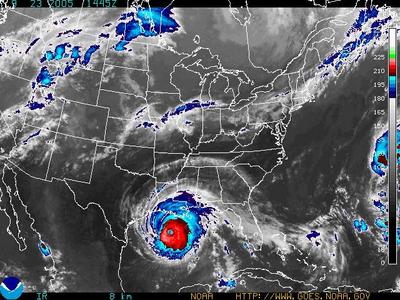


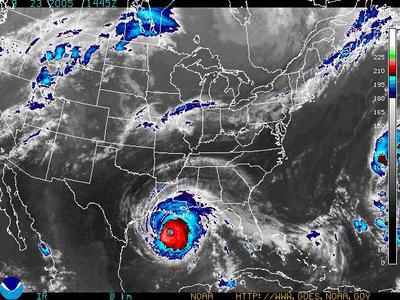
A planet by any other name...
Today, an International Astronomical Union working group will recieve two competing proposals. But as astronomers tell New Scientist, the debate could drag on indefinitely.
9.22.2005
Getting Around INA
The House has not yet acted.
"Human space exploration is essentially over."
Progress in society is measured by the extent to which work that is dangerous or menial is done by machines. The benefits we enjoy from the space program - weather satellites, communications satellites and global positioning - come from robotic spacecraft. Few scientists are calling for a human mission to the Moon or Mars. Human space exploration is essentially over. It is too expensive and provides too little return. But politicians know that the American public identifies progress in space with human astronauts.
The Bush administration's solution is to create an impossibly expensive and pointless program for some other administration to cancel, thus bearing the blame for ending human space exploration. The return to the moon is not a noble quest. It is a poison pill.
Expensive and dangerous? So is parking your car here in Manhattan. (I don't know about "menial," though.)
The debate about human v. machine-based exploration began at the dawn of the space era. You either go for the ol' "robots are the natural extension of our frail human bodies" argument, or, you want to leave things like astronomical observation and remote sensing to the machines, and send humans to settle the planets.
Of course, it's really only about money, and cheap, relatively safe space transportation solutions would to a large extent moot the whole problem. And with numerous commercial space ventures now in the works, someday routine space travel and tourism will be available.
Meanwhile, though Park refers to "some other administration" canceling the plan, members of Congress -- Republicans and Democrats -- this week are trying to kill NASA's exploration plan to help pay for earthly necessities like hurricane relief.
For now, sometimes it looks like the robots may be winning.
9.21.2005
Houston, we have a hurricane
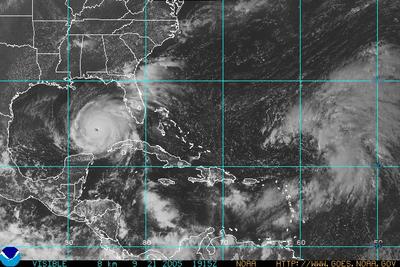 Bracing for the arrival of Hurricane Rita, now a cat five and the 9th 'cane of this dangerous and deadly storm season, NASA this afternoon closed Johnson Space Center, home of Mission Control in Houston, less than 50 miles from Galveston and the Texas Gulf Coast.
Bracing for the arrival of Hurricane Rita, now a cat five and the 9th 'cane of this dangerous and deadly storm season, NASA this afternoon closed Johnson Space Center, home of Mission Control in Houston, less than 50 miles from Galveston and the Texas Gulf Coast.JSC spokesman James Hartsfield reported NASA handed off primary control of the International Space Station to the Russian Mission Control Center outside Moscow until Rita passed.
Update: Just thinking back on the havoc caused by Tropical Storm Allison in southeast Texas in 2001. Records show Allison as "the costliest natural disaster in Houston's history." There's a record nobody wishes to break.
Waiting for the space elevator
"I'm all for returning to the Moon, but I wonder if this plan is the way to do it. Or, for that matter, the best investment of $100 billion toward spaceflight over the next 12 years.(And if you've missed recent TCS columns on space elevators, including the now classic one focusing on upcoming issues in space elevator law, I've got links here and here. Read on.)
The problem is that this NASA approach looks like more of the same. Oh, it's better than some earlier efforts: The program emphasizes astronauts learning to "live off the land" via lunar resources, an approach that seemed quite radical back when Bob Zubrin was first championing it. But the technology looks old -- and not "proven reliable," as Space Shuttle components have been less than ideal -- and I don't see any way this program will deliver what we need most: High flight rates and low costs.
I wonder, then, if the money wouldn't be better spent on things that have a higher likelihood of delivering those, like space elevators. As I mentioned in an earlier column, space elevator technology promises drastically reduced costs to orbit (from which, as Robert Heinlein famously observed, you're halfway to anywhere in the solar system in terms of energy) and it looks as if we could build a working space elevator -- or several -- within the $100 billion pricetag and over the same time frame."
Meanwhile, over at Slahdot, an ongoing thread on NASA's new shuttle has kicked up some commentary on space elevators, including logistics, Lagrange points and Earth v. Moon based elevators. And this comment: "It's a long trip in an elevator and the muzak will drive you crazy."
Never fear. The professor, who is also a musician, owns a record company.
9.20.2005
Mirmina on Nuclear Power Space
Steve graciously forwarded to me a copy of the article, with permission to post, and here it is: Nuclear Power Sources and Future Space Exploration (co-authored with clerk, David J. Den Herder).
Fascinating. Give it a read. And thanks, Steve!
9.19.2005
Apollo, reinvented
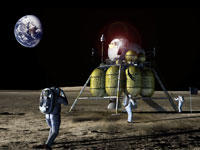 Actually, it's been hard not to "think of it as Apollo on steroids," as Mike Griffin suggested. According to NASA's plan, officially unveiled today (leaks? what leaks?), the new lunar exploration vehicle "will be shaped like an Apollo capsule, but it will be three times larger, allowing four astronauts to travel to the moon at a time."
Actually, it's been hard not to "think of it as Apollo on steroids," as Mike Griffin suggested. According to NASA's plan, officially unveiled today (leaks? what leaks?), the new lunar exploration vehicle "will be shaped like an Apollo capsule, but it will be three times larger, allowing four astronauts to travel to the moon at a time."Will the new spaceship make the Vision a reality? Is the plan at all realistic? Forget that silly shuttle sitting idle again with no launch date, we're off to the moon by the end of the next decade, then on to Mars and beyond? To many, for a load of fiscal, political and other reasons, it sounds like a long shot. But when, for the public sector, and now, private spaceflight ventures as well, has space travel been anything else? (Still, it seems so strange that going to the moon is but a vision again. I had a dream we were there already, didn't you?)
Here is a fact sheet on the exploration architecture and new spaceship.
Meanwhile, as you're orbiting your favorite space blogs and zines, don't miss Daniel Handlin in The Space Review, Where do we go from here? Making the Vision for Space Exploration a reality: "Clearly the issue in returning humans to the Moon is not technical. The problem is getting and sustaining the will to undertake the journey."
And Rand Simberg does the math and thinks NASA's plan is nuts.
By the way, for you up-and-coming space lawyers who represent or want to represent clients who do or want to do business with NASA, dig into the space agency's explorations systems acquisition portal for information about crew exploration vehicle procurement and related hot stuff. (While it lasts?)
9.16.2005
Friday Flybys (vol. 18)
* * *
Jeff Foust (who knows everything that happens in the Washington space arena and everybody who makes it happen), is following Senate Foreign Relations Committee Chairman Richard G. Lugar's (R-IN) bill to amend the Iran Nonproliferation Act to allow NASA and U.S. corporations to buy Russian space equipment until 2012. More to come.
* * *
The lunar exploration plan rolls on... NASA has briefed the White House on its new exploration architecture (yes, the Exploration Systems Architecture Study). Monday the thing goes public. Keith Cowing has these updates. Meanwhile, Keith says, "As to what it will look like: think Apollo - both for what it will feature - and what it will not feature - as well as how things will look- and how they will work. Mars is only a footnote - a distant one at that."
* * *
Space Law in Nigeria . . . Jim Volpe sent me a reminder about the United Nations/Nigeria Workshop on Space Law, titled, "Meeting international responsibilities and addressing domestic needs," scheduled for Abuja, Nigeria, November 21-24, 2005. (The organizers make reference to a registration deadline of Sept. 12 but that date appears to have been extended already, so if you are interested and missed that apparently arbitrary date, let them know.)
* * *
So how much would you invest in start-up 4Frontiers' vision to put a human settlement on Mars in 20 years? (AP via BusinessWeek Online)
* * *
Alrighty... Ed Minchau aka robot guy, sent me (in response to this Space Law Probe post) a heads-up about a 1981 movie called Outland starring Sean Connery -- a murder-mystery set in a mining colony on Io. I'm off to try to get my hands that video. (Since nobody asked me out tonight to see Magnificent Desolation.) And by the way, if you get the chance this weekend, whip up a batch of Sen. Barbara Mikulski's famous crab cakes -- they're scrumptious.
Malaysian Astronaut Idol
The problem is, in a nation of 24 million people, how to pick the best astronaut? The answer: Have a contest! Let the people vote online!
The Malaysian space agency (Angkasa) wants the astronaut who is not only physically and psychologically fit, but "able to relate to the people and serve as an inspiration to the country's youth."
It is unclear on whether the first Malaysian astronaut selection process will be similar to that of popular reality-based TV shows featuring mass Web voting, such as American Idol -- or, more to the point, Malaysian Idol.
(Personally -- and I haven't seen photos of all the contestants -- but as it stands, I'd vote for the astronaut hopeful pilot who cheated death. He's brave, and has good teeth and a great smile. If only he could sing like Kelly Clarkson...)
9.15.2005
Astrologer Suit Proceeds against NASA
Prior to suing for damages, Ms. Bay brought an unsuccessful action to force NASA to cancel its comet smashing Independence Day mission.
(There is no word on whether Ms. Bay's lawyer is considering adding a claim against NASA for its part in funding the recent discovery of the "10th planet" (2003 UB313). That must have really messed up her charts.
Here on Space Law Probe we don't judge the disgruntled astrologer too harshly. She just hasn't been herself ever since fragments of comet Shoemaker-Levy 9 collided with Jupiter in 1994.
Whatever the outcome, let's hope Mercury isn't in retrograde when the court rules in this case.)
InstaSingularity
(You missed it? No you didn't. In response to my post titled, Is Space Law Like Sex, the funny professor posted YES, IT IS, because you just want to do it again and again. Whoooosh. The smoke is still pouring out of my hit counter. By the way, I did want to follow up. Here's a personal message for all 80,000,000,000 plus visitors who discovered Space Law Probe for the first time last Thursday. I have your domain. I have your IP address. Now that we've been properly introduced and we're all friends -- and this is the kind of girl I am -- I'm coming to your homes and workplaces to make sure you do not forget to bookmark Space Law Probe, subscribe to the feed, check in every day, and of course, add Space Law Probe to your blogroll.
And whatever you do, don't wait for another link from Instapundit. Professor Reynolds is busy and he may not get back around here for some time. (Unless he links to this post? Naaah...) Meanwhile, Space Law Probe is here for you. (Keep in mind, this is just a niche little space "blawg" and there's really no way to actually include *sex* or oblique references thereto in a lot of posts without sounding rather strange. But I'll do what I can.)
Because in the end, the lesson is clear, and sooner or later every blogger in the linkosphere who is lucky enough to get the big rush, to experience those 15 earth-shaking minutes of instafame learns it: When the Instapundit links to your blog, it really is like sex -- you want him "to do it again and again."
Space security: both sides now
Here's a selection of goodies, for your reading pleasure (pdf only):
Global Missle Defense for the 21st Century, Ambassador Henry F. Cooper, chairman, High Frontier
Policy and Legislative Options for Parliamentarians Regarding Possible Deployment of Further Military Capabilities in Outer Space, prepared by the law faculty at the Institute of Air and Space Law (IASL), McGill University, Montreal, Canada (June 2005)
Background Paper: "Peaceful" and Military Uses of Outer Space: Law and Policy, also by the IASL faculty (Feb. 2005)
U.S. Military Space Policy and Strategy Presentation to the e-Parliament Conference on Space Security, Theresa Hitchens, Vice President, Center for Defense Information
US Military Transformation US Military Transformation and Weapons in Space, Dr. Everett Dolman, U.S. Air Force's School of Advanced Air and Space Studies
Safeguarding Space Security: missile defence and the challenge for Europe, Dr. Rebecca Johnson, Acronym Institute for Disarmament Diplomacy
Right. And now that you've studied the documents and replayed the webcast, you can make up your own mind.
9.14.2005
Cut the space object in half?
I love astronomers but really, sometimes they are as bad as lawyers.
(I'm just thankful this blog isn't Space Ethics Probe.)
e-Parliament Hearing on Space
Sounds like it could be interesting; in any case, it's definitely different: Today, the U.S. Congress will host legislators from Australia, Brazil, Britain, Denmark, the European Parliament, Ghana, Italy, Japan, Mexico and Norway for the "first online global parliamentary hearing" devoted to space issues (in fact, the first e-Parliament hearing ever). The hearing will be webcast live and open to participation by journalists worldwide.
Here is the announcement from e-Parliament. According to the release, "The hearing will focus on the future of outer space, and in particular on the possible deployment of weapons in space. The use of space weapons is under consideration by the US Air Force and is becoming controversial. "
(Becoming controversial?)
The webcast link is here (however, I tried to access the page, along with the main e-Parliament site, at various times yesterday all was down... still is. Maybe the organizers really don't want audience participation after all? I'll update later.)
----------------------------
UPDATE: It's up. Nice site. Webcast starts 10:00am Eastern time (14:00 GMT), one hour from now.
9.13.2005
Space Station Blues

Jeff Foust captures the views of some space experts who met last week on a panel to chew on The trouble with space stations. It wasn't pretty . . .
* * *
It’s always easier to draw these things than to build them.
--Roger Launius,
National Air and Space Museum historian
My argument [is] that’s it’s the sheer magnitude of the task.
--William Dwyer,
NASA’s Johnson Space Center (engineer, worked on both Freedom and ISS)
I really think that we have taken on an incredible challenge here.
--Al Diaz
Formerly NASA’s associate administrator for science
The problem I have seen with the space station is that the requirements are constantly in motion.
--Keith Cowing,
NASA Watch (who worked at NASA’s space station program office)
We have the wrong people working the wrong system doing the wrong job the wrong way and for the wrong reason.
--Rick Tumlinson,
Space Frontier Foundation co-founder
ITAR has to be changed.
--Rick Tumlinson
We don’t need a space station to go to the Moon.
--Chris Faranetta,
Space Adventures, vice president of the orbital space flight program
9.12.2005
FAA Gives LiftPort Thumbs Up
As Liftport explains, "The lifters are early prototypes of the technology that the company is developing for use in its commercial space elevator to ferry cargo back and forth into space.
The tests, which are planned for early fall, will simulate a working space elevator by launching a model elevator 'ribbon' attached to moored balloon initially up to a mile high. The robotic lifters will then be tested in their ability to climb up and down the free-hanging ribbon, marking the first-ever test of this technology in the development of the space elevator concept."
LiftPort Group president Michael Laine said the FAA waiver "represents an important milestone for us as well in the development of our overall space elevator concept." (Via NanoInvestorNews)
NASA's Second in Command
 With Senate Judiciary Committee confirmations hearings of Judge John Roberts underway today, it's nice to have a nomination for a top government job that should be easier for folks to agree on:
With Senate Judiciary Committee confirmations hearings of Judge John Roberts underway today, it's nice to have a nomination for a top government job that should be easier for folks to agree on:The White House announced it will tap Shana Dale to be Deputy Administrator of NASA. Ms. Dale, a lawyer, would be the first woman to hold the number two slot at the space agency.
Shana Dale is currently the Deputy Director for Homeland and National Security at the Office of Science and Technology Policy (OSTP).
Previously she served as chief of staff and general counsel at OSTP.
She has made her mark in space law and business matters. Women in Aerospace notes, "Ms. Dale was the first woman to hold the position of Staff Director of the House Subcommittee on Space and Aeronautics of the Committee on Science. Her leadership led to legislation directing NASA to purchase science data and services from the commercial sector, including the pioneering Scientific Data Purchase Initiative. While serving as Subcommittee Staff Director, Ms. Dale co-drafted, negotiated, and managed the Commercial Space Act of 1998 through enactment; managed an investigation into the safety of the Mir space station; and investigated and staffed a hearing on potential missile technology transfers to China. Ms. Dale has served as an outstanding role model for women seeking senior positions to impact federal research and development investments in space science, technology, and aeronautics."
She received he J.D. from California Western School of Law.
Space Law Probe congratulates Shana Dale. (And best luck to the departing deputy administrator, Fred Gregory whose retirement NASA announced on Friday.)
9.09.2005
Hurricane Flybys
------------------------------------------------------------------------------------------------
Hurricane blows away launch date:
Not that NASA had a launch date for the next shuttle mission. But now, with half of the 2,000 workers at the Michoud Assembly Facility east of New Orleans still unaccounted for, and damage to Michoud and Stennis Space Center estimated at $1.1 billion, including repair of buildings and providing homes and help for displaced employees and contractors, NASA cannot say when the shuttle will fly again.
* * *
A hit, a miss:
One bright note appears to be that another storm, Ophelia (not a moon of Uranus), which grew into a hurricane overnight and then weakened back into a tropical storm by morning, will likely spare Florida and Cape Canaveral, despite fears yesterday. And computer models now show no risk it will enter the Gulf coast. (However, we are warned Ophelia does have the potential to loop around and restrengthen into a hurricane over the next day or so. Hurricanes so suck.)
* * *
California dreamin'...
A Californian writes to Alan Boyle suggesting that to avoid future hurricanes, "NASA and its contractors might consider moving back out to the West Coast and move its displaced workers at the same time. The facilities are still here at Plant 42, Edwards Air Force Base and Phillips Laboratory as well as throughout Southern California."
But Alan points out, "there's so much infrastructure in Cape Canaveral, both physical and intellectual, that it would be difficult to contemplate a move."
And see Rand Simberg's interesting elaboration as to why launching shuttles from the sunshine state is not that simple. (Apart, that is, from the California hazards Rand's readers mention, such as brushfires, earthquakes and Sean Penn. But hey, don't look at me, I love California.)
* * *
Florida dreamin'...
And no word that Space Adventures is thinking twice about maybe basing its space tourism operations somewhere other than in the hurricane zone. (link via Alan Boyle)
* * *
Be safe and dry.
Elon the Falconer
Elon Musk's Falcon 9 has liftoff, at least in blogspace.
I'm with Clark Lindsey: "OK, until the Falcon I flies successfully, there will be plenty of skepticism about the Falcon 9. However, the fact that it already has a US government contract says that somebody did due diligence on the vehicle and gained confidence in its feasibility. This is going to have a huge impact on the aerospace industry."
And Clark quotes The Wall Street Journal commenting on how "surprising" it is that SpaceX, "a startup company with barely more than 100 employees is now maneuvering to compete against aerospace giants such as Boeing Co., Lockheed Martin Corp. by developing a more powerful version of its initial rocket, which can blast payloads of more than 21,000 pounds into low-earth orbit." Indeed.
Jon Goff and Dan Schmelzer and Dan Schrimpsher are impressed, too.
9.08.2005
Is Space Law Like Sex?
First, I acknowledge: Some people in the space community worry that Prof. Glenn Reynolds has veered too far from his roots as a space law expert and author. Sure, his renowned space law book sells every day on Amazon. And we see how he does return to the fold in his regular Tech Central Station column when he writes about law relating to space elevators and other important topics.
But look at some of the extraneous things with which our beloved space law professor involves himself.
Never mind his many articles along the lines of, for example, Is Democracy Like Sex?
What about his appearing on countless TV shows and radio broadcasts, talking with the other, if I may, pundits, about any topic under the sun, not necessarily space at all? And what's with hosting that blog (or even that other blog) -- undertakings that could easily tend to distract the professor from pressing space law business? (Incidentally, you have to look carefully on the About Me page of one of the top blogs on earth because unless you click the correct link you will find no mention of the host's involvement and interest in the field of space law. None.)
Folks in space law and industry wonder: What gets into him? What is he thinking?
But every now and again, like today, there is a glimmer of hope. Yes, this summer Prof. Reynolds published a new journal article on space law -- this one for the Chicago Journal of International Law summer 2005 symposium on space law. And here it is:
(By the way, did he put the article on Instapundit? Well nooooo. You see what I mean? But never mind. I got a copy, along with permission to post it to Space Law Probe.)
International Space Law in Transformation: Some Observations
Vintage Reynolds. Here we get some of his current musings and insights on space tourism, space militarization, space environmental issues and other select topics. Of course he could have gone on for chapters and chapters. If he wasn't so... distracted... with other things. You know. But clearly we see that although the good professor has strayed, and quite shamelessly, he still knows and loves space law. He remembers where it all began for him. Despite his wanderings.
So who knows? Maybe the professor will come back for good. And we can help. Anytime he wants, Prof. Reynolds can come over here and guest blog Space Law Probe. Annnnytime.
Sure. After all, you can take the professor out of space law and blast him into an impossibly alluring orbit of fame and fortune in the blogosphere and beyond.
But you can't take the space law out of Professor Reynolds.
9.07.2005
Orbiting Witnesses
It's not exactly a new idea. Missy Frederick at Space.com has a recent interesting example: Lawyers for the state of Arizona got their hands on images from Space Imaging's Ikonos satellite for a case against a developer accused of illegally clearing hundreds of acres of state trust lands and thousands of acres of private lands along with portions of several Native American archeological sites. Was the land bulldozed clear as Arizona claims? Ikonos doesn't lie.
And Space Imaging doesn't mind bragging about its satellite's starring role in the case, either. After all, orbiting 423 miles high, the satellite can see objects on earth as small as one meter.
As Professor Joanne Gabrynowicz, director of the National Remote Sensing and Space Law Center told Space.com, the strategy of using satellite images is "very successful because it's very persuasive evidence." She pointed out that some attorneys settle out of court rather than face a trial when they are up against satellite images. Professor Gabrynowicz even recalls that the L.A.P.D. contacted her to ask if there was any imagery that could help it in the O.J. Simpson murder trial. "There wasn't, but it's important they're sophisticated enough to know it exists and to ask the question."
As we've seen, other users of satellite images include government agencies looking into insurance fraud by farmers, farm-program compliance and environmental law violations. (See, Who's watching your farm?)
Meanwhile, the technology advances and satellite imagery grows cheaper and more widely available. Future law in this arena will focus on the obvious big brother concerns and related issues associated with shooting high-tech pictures from orbiting cameras. More litigation, naturally, will follow.
Astronaut's Troubled Son
According to the San Francisco Chronicle, the astronaut's son and namesake (and I will not repeat the name here), was arrested under a new law intended to crack down on sex tourism. Of course, here at Space Law Probe we're only interested in space tourism, not sex tourism.
9.06.2005
U.S. Government Space Sector
The course, co-sponsored by the American Astronautical Society and the Space Foundation, is a thorough and up-to-the-microsecond primer for government folks, space business types, their lawyers (of course), and others who either interface with our high-flying federal space agencies and offices, or want to. I recommend it. (Tell Ian Space Law Probe sent you!)
9.02.2005
Recovery Space
Here is N.Z. Bear's Hurricane Katrina: Blog for Relief Weekend page (including a log of participating bloggers). You just want to hug him. And the omniscient Professor, of course, has the big list of recommended charities and resources working to collect funds.
I contribute to Habitat for Humanity because to rebuild lives blown apart by the storm and its aftermath, first and foremost, people need homes.
So do what you can for hurricane katrina relief and flood aid. (We are supposed to put in those links. Not sure why but there they are.)
I am a New Yorker and I remember the outpouring of assistance after 9/11/01.
And like New York, New Orleans and the Gulf states will rise again and prosper.
Above and Below
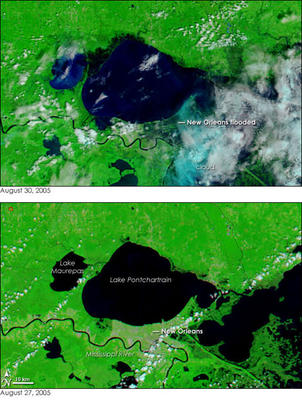 While the nation's valuable and ever-productive orbiting space assets watched safely and recorded Katrina's destruction from above, U.S. space facilities and employees in Mississippi and Louisiana experienced the terrible storm from the ground.
While the nation's valuable and ever-productive orbiting space assets watched safely and recorded Katrina's destruction from above, U.S. space facilities and employees in Mississippi and Louisiana experienced the terrible storm from the ground.Thankfully, Katrina caused no major damage to the two major NASA sites in the Gulf Coast --Michoud Assembly Facility in New Orleans and Stennis Space Center in Mississippi.
And NASA has no reports of injured employees or contractors. However, the agency says many homes of Stennis Space Center employees in Mississippi have been damaged or destroyed. And approximately 1,000 people including NASA employees, contractors and others are finding shelter onsite at Stennis.
Over at Michoud, Space.com reports that while workers at the external tank facility cleared debris, many of the 2,000 Lockheed Martin employees who worked at the facility remain missing or without housing.
Meanwhile, with Michoud closed, NASA considers Kennedy Space Center in Florida (a hurricane-free zone?) as an alternative site for external fuel tank work.
So... when will the space shuttle launch next? In the wake of Katrina, NASA now says May 2006 at the earliest.
By the way, ever-busy space shuttle program manager Bill Parsons is senior NASA official in charge of the hurricane recovery effort.
9.01.2005
Scary pictures from space...
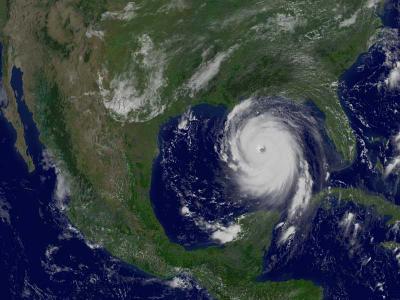
Hurricane Katrina in the Gulf of Mexico
credit: NASA; NOAA; GOES 12 Satellite
(Last night I heard Michael Brown, undersecretary of Homeland Security for
Emergency Preparedness and Response -- you know, the head of FEMA --
tell Larry King, "I must say this storm is much, much bigger than anyone
expected." I don't know. Maybe he missed some of the nonstop images
of the cat fiver making its way up the Gulf.
Here are just a couple more...) (credit: NOAA)



